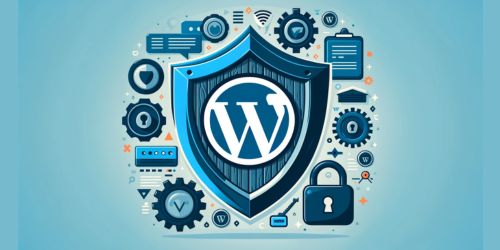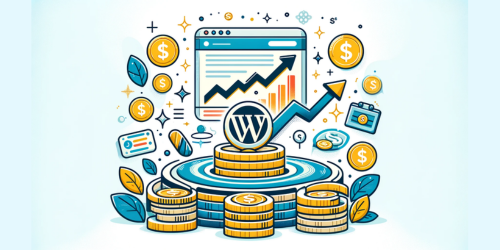Have you ever pondered the sheer magnitude of the digital universe that your WordPress site inhabits? It’s a realm where data is the currency, and security breaches are akin to bank heists. In this vast expanse, your website is not just a collection of pages and posts; it’s a fortress that houses valuable information. And like any fortress, its defenses must be impregnable.
WordPress, powering an impressive swath of the internet, is besieged daily by digital marauders seeking to exploit any chink in its armor. Herein lies the crux of our discourse: the paramount importance of WordPress security. This isn’t just another article; it’s a comprehensive security manifesto, meticulously crafted to fortify your online presence against the relentless onslaught of cyber threats.
As we navigate through this guide, we’ll arm you with strategic insights and tactical knowledge, transforming your WordPress site from a vulnerable outpost into a bastion of digital safety. Let’s embark on this journey to elevate your WordPress security to an art form, ensuring that your site remains an unassailable digital citadel.
1. Understanding WordPress Security: A Primer
WordPress security is the armor that shields your website from the onslaught of cyber threats lurking in the digital shadows. It encompasses everything from safeguarding sensitive data to thwarting unauthorized access, ensuring that your site remains a trusted haven for your visitors. For website owners, robust security is not a luxury; it’s a cornerstone of digital trustworthiness.
A secure WordPress site not only protects your content and user data but also upholds your reputation, fortifies your SEO rankings, and ensures uninterrupted business continuity. In essence, WordPress security is the guardian of your online integrity.
2. Choosing a Secure Hosting Environment
Selecting the right hosting provider is akin to choosing a foundation for your digital domicile; it’s pivotal for your WordPress site’s security. A robust hosting platform acts as the first line of defense, offering essential features such as SSL certification, which encrypts data between user browsers and your server, creating a secure channel for information exchange. Regular backups safeguard your content, allowing for quick restoration in case of data loss, while malware scanning capabilities proactively detect and neutralize threats. In the realm of web security, a secure hosting environment is not just a feature—it’s the bedrock of your site’s safety.
3. The Pillars of Password Hygiene
In the digital fortress that is your WordPress site, passwords are the sentinels at the gate. Crafting strong, complex passwords is non-negotiable; they should be a cryptic tapestry of letters, numbers, and symbols, defying the attempts of intruders. Equally critical is the ritual of regular password updates—a dynamic defense strategy that keeps adversaries perpetually off-balance. Consider leveraging password managers to store and generate these cryptographic keys, ensuring that each password is as unassailable as the last.
4. Layered Defense: The Role of Two-Factor Authentication
Two-Factor Authentication (2FA) adds a robust layer to your security stratagem, akin to a drawbridge in addition to your fortress walls. It requires a second form of verification—often a code sent to a mobile device—ensuring that a password alone is not enough to breach your digital domain. Implementing 2FA can be as simple as installing a reliable plugin that integrates seamlessly with your WordPress environment. This dual-layered approach significantly reduces the risk of unauthorized access, keeping your site’s sanctity intact.
5. Admin Username: Your First Line of Defense
The default “admin” username is a beacon for attackers, a universal key they’ll try first in their nefarious endeavors. Retaining this username is akin to leaving your digital front door ajar. To bolster your defenses, navigate to your WordPress dashboard and create a new user with administrative privileges, but with a unique, unpredictable username. Subsequently, delete the old “admin” account, transferring all content to your newly created profile. This simple act is a strategic maneuver in obscuring access points from would-be attackers.
6. Brute Force Attacks: Prevention Over Cure
Brute force attacks are the battering rams of the cyber world, relentlessly guessing passwords until they strike gold. To fortify your site, employ strategies such as limiting login attempts which act as a barrier, halting continuous password guesses. Additionally, implementing a lockout policy deters repeated attempts by temporarily disabling login access after a set number of failed tries. These preemptive measures are not just deterrents but essential protocols to ensure that the brute force of cyber onslaughts meets the immovable object of your site’s security.
7. Keeping Your WordPress Environment Updated
In the ever-evolving landscape of cybersecurity, keeping your WordPress core, Rewrite plugins, and themes updated is not just maintenance; it’s a survival tactic. Each update not only enhances functionality but also patches vulnerabilities, slamming shut any windows of opportunity for hackers. Regularly check for updates or set them to automatically install, ensuring you’re always fortified with the latest digital armor. It’s a simple, yet critical routine that serves as the immune system for your website, warding off the pathogens of the internet.
8. The Safety Net: Regular Backups
Imagine a safety net that can catch your digital content, no matter how high the wire. That’s what regular website backups provide. They are the undo button in the face of calamity—be it a hacker’s havoc or a faulty update. Employing automated backup solutions ensures that your data is regularly duplicated and stored in a secure location. This practice is not just recommended; it’s the bedrock of a sound WordPress security strategy, offering peace of mind and the assurance that your content can always be restored to its former glory.
9. SSL Certificates: Encrypting Data Transfer
SSL certificates are the secret agents of the internet, working behind the scenes to encrypt data transfers. This encryption turns readable data into an indecipherable code as it travels between the user’s browser and your server, thwarting eavesdroppers and data thieves. Transitioning from HTTP to HTTPS, courtesy of an SSL certificate, not only protects data but also boosts customer trust and search rankings. Begin this mission by acquiring an SSL certificate and implementing it, ensuring every byte of data is a cryptic puzzle for unauthorized eyes.
I. Hardening WordPress: Technical Measures for Robust Security
Hardening your WordPress site is like reinforcing the walls of your digital fortress. It involves steps like changing the database prefix, setting file permissions, and disabling file editing within the dashboard. To streamline this process, consider plugins like iThemes Security or All In One WP Security & Firewall that offer a suite of hardening features. These technical adjustments are your silent guardians, deflecting threats with their robust protocols.
ii. Restricting User Access: A Strategic Move
In the realm of WordPress, knowledge is power, and power should be guarded. Limiting user access is about entrusting the right level of site management to the right individuals. Employ best practices for user role management, assigning roles from subscriber to administrator based on necessity, not convenience. This minimizes risk, ensuring that only those with a need to wield such digital power can do so, keeping your site’s operations secure and streamlined.
iii. Automated Vigilance: The Role of Security Plugins
Security plugins serve as the tireless sentinels of your WordPress site, offering automated vigilance against threats. They scan for malware, monitor for suspicious activity, and enforce strong password policies. Championing plugins like Sucuri or MalCare can be a game-changer, providing a comprehensive shield that adapts to the ever-changing threat landscape. These plugins are not just tools; they’re your allies in the ongoing battle for digital security.
iv. Disabling XML-RPC: Closing a Common Vulnerability
XML-RPC facilitates remote connections to your WordPress site, but it’s also a favored target for attackers. Disabling it can close off this vulnerability, cutting off a potential access route for attackers. To disable XML-RPC, you can add the following line to your site’s .htaccess file:
add_filter('xmlrpc_enabled', '__return_false');This small tweak to your site’s configuration can significantly bolster its defenses.
v. Directory Browsing: Why It Should Be Disabled
Directory browsing is like leaving your file cabinet unlocked and open for anyone to rummage through. It exposes your site’s structure and files to prying eyes, inviting mischief. To lock down your directories, insert the line Options -Indexes in your .htaccess file. This simple action denies browsers the ability to list the contents of directories, keeping your site’s architecture hidden from unauthorized reconnaissance.
vi. Concealing WordPress Version: A Simple Yet Effective Tactic
Flaunting your WordPress version is like announcing the blueprints of your security system—it can give attackers a head start. To conceal your version number, add the following snippet to your theme’s functions.php file:
remove_action('wp_head', 'wp_generator');This clever trick ensures that your WordPress version remains a mystery, leaving potential attackers in the dark.
vii. Database Prefixes: A Small Change with Big Impact
The default ‘wp_’ prefix for WordPress database tables is a tell-tale sign easily exploited by SQL injection attacks. Altering this prefix to something unique is a strategic maneuver that can significantly reduce risk. To change it, you’ll need to rename your database tables and update your wp-config.php file accordingly. This small change is a subtle yet potent tweak in your security arsenal.
10. Conclusion: Your Action Plan for WordPress Security
In the quest for impenetrable WordPress security, we’ve traversed the landscape of SSL certificates, hardened defenses, and vigilant plugins. We’ve locked down admin access, cloaked our WordPress version, and changed database table prefixes to confound potential intruders.
Now, it’s time to translate this knowledge into action. Begin by auditing your site, updating your protocols, and implementing the strategies discussed. Remember, the strength of your WordPress site’s security is the sum of these parts, diligently applied. Don’t wait for a breach to remind you of the importance of security—act now, and fortify your digital presence.
11. FAQS
What security does WordPress have?
WordPress has built-in security features such as regular software updates, password protection for content, and user role management. Additionally, it supports SSL certificates and has a large community constantly monitoring and patching any vulnerabilities.
What are good ways to make WordPress more secure?
To make WordPress more secure, regularly update your WordPress core, themes, and plugins, use strong passwords, implement two-factor authentication, choose a secure hosting provider, and install reputable security plugins.
What security measures do you add when developing WordPress sites?
When developing WordPress sites, enforce strong passwords, use security plugins, implement SSL encryption, harden .htaccess files, disable file editing via the dashboard, and regularly back up your site.
What are the security risks of WordPress?
The security risks of WordPress include outdated core software, themes, and plugins, weak passwords, unsecured hosting, and susceptibility to common attacks like SQL injection, cross-site scripting (XSS), and brute force attacks.



